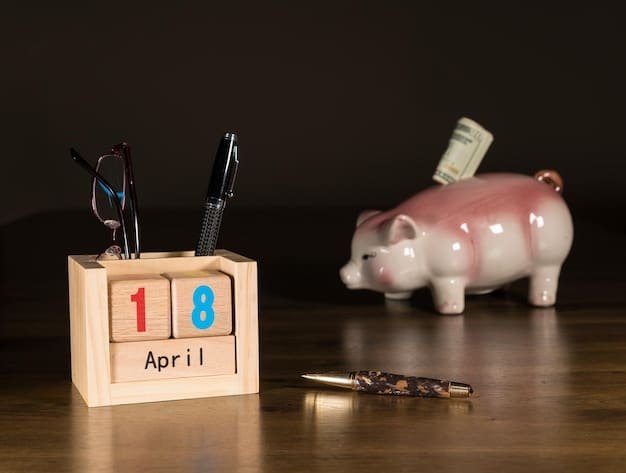Stop Overspending: Master the 72-Hour Rule to Save Money

Stop overspending by using the 72-hour rule, a simple yet effective technique where you delay any non-essential purchase for 72 hours to evaluate if you truly need it, helping you avoid impulse buys and save money.
Do you often find yourself regretting impulse purchases? The stop overspending by employing the 72-hour rule can be a game-changer in your financial life. It’s a straightforward strategy that introduces a cooling-off period before you commit to non-essential purchases, helping you to distinguish between wants and needs.
Mastering the 72-Hour Rule to Curb Impulse Spending
Impulse buying is a common pitfall, leading to unnecessary expenses and financial strain. The 72-hour rule provides a structured approach to managing these impulsive desires, giving you time to reflect on the true value and necessity of a potential purchase. This rule is not just about delaying gratification; it’s about making informed decisions that align with your financial goals.
The Psychology Behind Impulse Buying
Understanding the psychological factors that drive impulse buying is the first step in gaining control. Often, these purchases are triggered by emotions, stress, or marketing tactics designed to create a sense of urgency.
How the 72-Hour Rule Interrupts the Impulse Cycle
By introducing a waiting period, the 72-hour rule disrupts the impulse cycle, allowing you to detach emotionally from the item and evaluate it objectively.
- ⏱️ It creates a buffer between the initial urge and the purchase.
- 🧠 It allows you to consider whether the item fits into your budget.
- ✅ It provides an opportunity to research alternatives and compare prices.
- ✨ It encourages mindful spending habits.
By understanding the triggers of impulse buying and using the 72-hour rule, you can proactively manage your spending habits and align them with your long-term financial objectives. This simple technique helps you avoid immediate gratification and makes thoughtful decisions so your economic needs are met.

Implementing the 72-Hour Rule: A Step-by-Step Guide
Implementing the 72-hour rule is simple, but requires commitment and consistency. This guide will walk you through the steps, providing practical tips on how to make this strategy an integral part of your spending habits and making a meaningful impact on your savings goals.
Identify Potential Impulse Buys
The first step is to identify situations and items that trigger your impulse buying tendencies. These might include online shopping, social media ads, or browsing through stores.
The 72-Hour Waiting Period
When you encounter an item you’re tempted to buy, resist the urge to purchase it immediately. Instead, write it down on a list or place it in your online shopping cart, and commit to waiting 72 hours before making a decision.
- 📅 Note the date and time when you first considered the purchase.
- 🚫 Avoid browsing similar items during the waiting period.
- 🧘 Engage in activities that distract you from the impulse.
- 💬 Discuss the purchase with a trusted friend or family member.
Use the waiting time to reflect on the purchase and decide based on need. Following the steps above will allow you to take control of spending rather than spending taking control of you.
Benefits of Using the 72-Hour Rule
The 72-hour rule offers multiple advantages. Going beyond just saving money, the decision-making process it promotes leads to increased financial awareness. By delaying impulse purchases and thinking, this leads to more thoughtful spending habits.
Reduced Impulse Spending
The most obvious benefit is a reduction in impulse spending, leading to more money left in your account each month.
Increased Financial Awareness
The 72-hour rule encourages you to think about your spending habits, giving you greater insight into your patterns, triggers, and motivations.
Adopting the 72-hour rule can create the following:
- ✅ Improved budgeting and financial planning.
- 💰 Greater awareness of your financial goals.
- 🧘 More mindful and intentional spending.
- ✨ Increased self-control and discipline.
Ultimately, the 72-hour rule can transform your relationship with money, enabling you to align your spending with your values and goals. The rule is a simple, yet powerful, tool for gaining control over your finances. A small waiting period is important to a happy future.

Overcoming Challenges When Applying the 72-Hour Rule
While the 72-hour rule is straightforward, you may face challenges in implementing it. These challenges can be overcome with awareness and strategic thinking to stay on track toward your financial goals.
Emotional Triggers
Emotions can be important drivers of impulse purchases. Recognizing and managing these triggers is critical to sticking to the 72-hour rule.
Marketing Tactics
Marketers often employ tactics such as limited-time offers and flash sales to create a sense of urgency and encourage instant purchases.
To overcome these obstacles:
- 🧘 Practice mindfulness: Be aware of your emotions and how they drive the decision-making process.
- 🧐 Question your motivation: Ask yourself if the purchase is truly necessary or fulfilling emotional needs.
- 🛡️ Avoid temptation: Unsubscribe from promotional emails and limit exposure to online shopping.
- 🤝 Seek support: Share your goals with a trusted friend or family member who can offer encouragement.
By proactively addressing these challenges, you can reinforce your commitment to the 72-hour rule. Make plans to resist temptation and foster mindset focused on long-term financial success.
Real-Life Applications of the 72-Hour Rule
The 72-hour rule applies across situations. From small everyday purchases to more significant investment decisions, the principles remain the same: delay, reflect, and decide based on need.
Everyday Purchases
For smaller items, such as clothing, electronics, or home goods, applying the 72-hour rule can prevent mindless spending and ensure that purchases are aligned with your needs and budget.
Large Investments
For larger investments, such as cars, appliances, or vacations, the 72-hour rule provides an invaluable opportunity to conduct thorough research, compare prices, and assess the financial implications.
Here are some examples for the above categories:
- 🚗 Car: You find a new car. Don’t buy it right away. Wait and examine all options.
- ✈️ Vacation: You find a vacation idea. Don’t book right away. Weigh pros and cons.
- 👕 Clothing: There is a new type of clothing you want. Wait to see if you really want to buy it.
- 📱 Electronics: There is a new electronic that looks fun. Think about how frequently you would use it.
Adapting the 72-hour rule to various scenarios empowers you to make responsible financial choices and prioritize long-term financial security. When used correctly, the 72-hour rule can change ones whole economic outlook to a happy one.
Combining the 72-Hour Rule with Other Financial Strategies
The 72-hour rule is more effective when complemented by other financial strategies. When combined with budgeting, goal setting, and financial education, it can become a tool for financial transformation.
Budgeting
Creating a budget provides a framework for tracking income, expenses, and savings. Combining this with the 72-hour rule ensures that spending aligns with your priorities.
Financial Goal Setting
Setting clear financial goals, such as saving for retirement, paying off debt, or buying a home, provides motivation and direction for financial decisions. The 72-hour rule reinforces your commitment to these goals by preventing impulsive spending that detracts from them.
Additional tips for combining financial strategies:
- 📚 Educate yourself: Reading books and taking courses on personal finance.
- 🤝 Seek advice: Consult a financial advisor for personalized guidance and support.
- 📱 Utilize tools: Use budgeting apps and financial calculators to track expenses and savings.
- 📅 Review regularly: Periodically review your budget and financial goals to ensure they remain aligned with your needs and priorities.
Integrating the 72-hour rule with other financial practices creates a holistic approach to money management. Making a plan to integrate these will help you develop better economic decisions.
| Key Point | Brief Description |
|---|---|
| ⏱️ Delay Purchases | Wait 72 hours before buying non-essentials. |
| 🧠 Evaluate Needs | Assess if the purchase is a want or a need. |
| 💰 Save Money | Reduce impulse buys for financial health. |
| ✨ Financial Awareness | Increase understanding on where your money goes. |
Frequently Asked Questions (FAQ)
What is the 72-hour rule?
▼ It’s a strategy to avoid impulse buying by waiting 72 hours before buying non-essential items. This gives you time to decide rationally.
How does this rule help save money?
▼ It reduces impulsive purchasing by creating a mindful thought process by delaying immediate gratification. This leads to more responsible spending.
Can this rule be used for all purchases?
▼ Yes, it’s adaptable. Use it for small daily temptations or larger investments. This helps make the thought process part of every spending habit.
What if I forget about the item after 72 hours?
▼ If you forget, it likely wasn’t really needed. This confirms the purchase was an impulse, saving you money.





